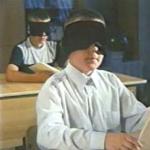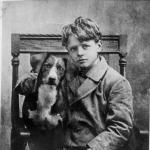The operating principle of any air conditioner is based on the property of liquids to absorb heat during evaporation and release it during condensation. To understand how this process occurs, let’s consider the air conditioner diagram and its design using the example of a split system:
The main components of any air conditioner are:
- Compressor- compresses freon and maintains its movement along the refrigeration circuit.
- Capacitor— radiator located in the external unit. The name reflects the process that occurs during operation of the air conditioner - the transition of freon from the gaseous phase to the liquid phase (condensation).
- Evaporator— radiator located in the indoor unit. In the evaporator, freon passes from the liquid phase to the gaseous phase (evaporation).
- TRV (thermostatic expansion valve)— lowers the freon pressure in front of the evaporator.
- Fans— create a flow of air blowing over the evaporator and condenser. They are used for more intense heat exchange with the surrounding air.
The compressor, condenser, expansion valve and evaporator are connected by copper pipes and form a refrigeration circuit, inside which a mixture of freon and a small amount of compressor oil circulates. During operation of the air conditioner, the following process occurs:
- Freon gas enters the compressor from the evaporator at a low pressure of 3 - 5 atmospheres and a temperature of 10 - 20 ° C.
- The compressor compresses freon to a pressure of 15 - 25 atmospheres, as a result of which the freon is heated to 70 - 90 ° C and enters the condenser.
- The condenser is blown with air having a temperature lower than the temperature of freon, as a result the freon cools down and passes from the gaseous phase into the liquid phase, releasing extra heat. In this case, the air passing through the condenser heats up. At the exit from the condenser, freon is in a liquid state, under high pressure, the freon temperature is 10 - 20°C higher than the ambient air temperature.
- From the condenser, warm freon enters the thermostatic valve (TRV), which household air conditioners performed in the form of a capillary (a long thin copper tube twisted into a spiral). As a result of passing through the capillary, the freon pressure drops to 3 - 5 atmospheres and the freon cools down, some of the freon may evaporate.
- After the expansion valve, a mixture of liquid and gaseous freon with low pressure and low temperature enters the evaporator, which is blown room air. In the evaporator, freon completely transforms into a gaseous state, taking away heat from the air, as a result the air in the room is cooled. Next, gaseous freon with low pressure enters the compressor inlet and the whole cycle is repeated.
This process underlies the operation of any air conditioner and does not depend on its type, model or manufacturer. In “warm” air conditioners, a four-way valve (not shown in the diagram) is additionally installed in the refrigeration circuit, which allows you to change the direction of freon movement, swapping the evaporator and condenser. In this case, the indoor unit of the air conditioner heats the air, and the outdoor unit cools it.
Note that one of the most serious problems when operating an air conditioner occurs when the freon in the evaporator does not have time to completely transform into a gaseous state. Then liquid enters the compressor inlet, which, unlike gas, is incompressible. As a result, water hammer occurs and the compressor fails. There may be several reasons why freon may not have time to evaporate. The most common are dirty filters (this deteriorates the evaporator airflow and heat transfer) and the operation of the air conditioner when low temperatures outside air (in this case, supercooled freon enters the evaporator).
When buying a room air conditioner, it is very important to choose the right one technical characteristics and handle the installation responsibly. According to statistics, the majority of air conditioner breakdowns occur due to their incorrect and unqualified installation. Correct sequence Connecting the electrical circuit of the air conditioner is the key to its high-quality and long-term performance. If the air conditioner is installed incorrectly, the following may subsequently appear: negative characteristics: leakage of condensate into the room, leakage of freon, etc.
There are two types of installation of air conditioners in premises: standard and non-standard. Standard installation- the most common is to install the air conditioner near a window, since the compressor is located outside. It is possible to perform installation in rooms that have been renovated. This installation is not expensive and does not take much time.
Custom installation Air conditioning is quite an expensive and painstaking job, which is recommended to be done only during the renovation of the room, since it involves chipping the walls.
Regardless of which installation option you choose, to avoid all negative consequences, before starting installation of the air conditioner and mountings, it is worth finding out important points. For example, such as the external connection diagram and electrical diagram, the electrical supply system of the device, the location of the input devices, the cross-section of the wires and future cable routes, find out the characteristics of the walls involved in the electrical wiring route. Electrical diagram the air conditioner must comply with the rules for electrical installations and regulatory documents. The participation of a professional team of specialists with the necessary equipment is important.
Air conditioner connection diagram
The electrical connection diagram for the air conditioner includes the laying of external wiring, secured every 50 cm with special clamps. Electrical wiring placed in boxes is attached to the wall using glue and screws, and hidden electrical wiring is located in recesses in the wall in corrugated pipes, attached with clamps.
When choosing a place to install an air conditioner, first of all you need to take care of the aesthetic characteristics: design and interior. It is recommended to install the air conditioner in the ceiling area in a place where you do not spend a lot of time, as direct flows of cold air can lead to colds.
Refrigeration circuit diagram
Below is a diagram of the air conditioner refrigeration circuit.
The diagram was taken not from a textbook, but from the manufacturer’s service documentation, therefore the designations are given in English.

Compressor- compressor, the “heart of the air conditioner”. The compressor compresses the refrigerant and pumps it through the circuit.
Heat exchanger- heat exchanger,
- outdoor unit - external unit, that is, the condenser, cools the compressed freon below the condensation temperature
- indoor unit- indoor unit - evaporator, in which the working substance evaporates, lowering the temperature
Expansion valve- expansion valve
In other words, TRV is a thermostatic valve. Provides feed required quantity refrigerant.
In simple air conditioners, its role is played by a capillary tube, without any adjustment, in inverter systems - by an electronic expansion valve.
2-Way valve- two-way valve, that is, a regular valve, with two positions - open and closed
3-Way valve - three-way valve, in an air conditioner, this is the service port to which the pressure gauge hose is connected for measuring pressure or charging.
4-Way valve- four-way valve, provides refrigerant reverse for operation of the air conditioner in heating mode
Strainer- filter, in this diagram it is a filter-drier, since it is installed before the expansion valve (and after, since the system can operate in reverse mode and the refrigerant changes direction of movement).
Its task is to prevent moisture from entering the thin channel of the expansion valve - since moisture will clog it, preventing the refrigerant from passing through.
Muffler- muffler
The arrows indicate the direction of movement of freon along the contour:
- solid arrow - in cooling mode
- dotted arrow - in heating mode
Also in more complex and advanced air conditioners the following is installed:
- Pressure Sensors
- liquid separators
- bypass lines
- injection systems into the compressor
- oil separators
Multi split system diagram
Multi split system- this is an air conditioner that has one external unit and several internal ones

In this case, several more internal blocks are added, as well as:
Distributor- a distributor that splits the refrigerant flow and directs it to several indoor units.
The circuit also contains elements that are used not only in multi-systems:
Receiver tank - receiver.
The receiver has several purposes - protection against compressor water hammer, draining freon during repairs, etc.
IN in this case this is a linear receiver that prevents freon gas from entering the expansion valve
Scheme electrical connections external unit of split system:

Terminal- terminal block for connecting the interconnect cable for connection to the indoor unit.
N- electric neutral
2 - supplying power to the compressor from the control board of the indoor unit
3 - supplying power to the fan motor for operation at 1st speed
4 -
supplying power to the fan motor to operate at 2nd speed
5 - power supply to the four-wheel drive directional valve to switch to heating mode
Compressor
C- common - common output of the compressor windings
R- running - compressor working winding
S- starting - phase-shifting winding of the compressor motor, starting
Internal overload protector- internal overload protection
Compressor Capacity- an electric capacitor, in this case a working one (there are also starting capacitors, but currently not used in air conditioners)
Fan motor- engine, fan motor
Thermal protector- protection against overheating, usually placed directly on the motor windings and breaks the circuit when the temperature is exceeded.
Fan motor Capacitior - fan motor run capacitor
SV- solenoid valve - an electromagnetic valve that drives the four-way valve mechanism.
Air conditioner indoor unit diagram
Terminal block
On the terminal block, in addition to interblock connections, there are also clamps for connecting power (power can be supplied vice versa - to the external unit)
L, N- electric line and neutral of single-phase power supply
Filter Board - filter board, reduces the level of interference in the power supply network
Control Board - control board - controls all devices, receives data from all sensors, performs thermoregulation, displays information for the user, and performs self-diagnosis.

Main relay- main relay - a power relay that supplies voltage to the compressor.
Display board - The display module can be a line of LEDs that indicate the presence of power, the selected mode, an error code, or a display that also displays the temperature.
Thermistor - thermistor, thermistor, temperature sensor
Room temp. - room temperature sensor
Pipe temp. - temperature sensor of the heat exchanger tube, evaporator
Temperature sensors may also be located in:
- control panel - to maintain the temperature at the location of the remote control (for example, “I Feel” mode).
- at the inlet, outlet and midpoint of the evaporator
Step motor - stepper motor,
Used to open louver grilles or curtains covering a fan
Despite the fact that there are air conditioners in almost every home, only a few users correctly imagine the circuit diagram of such a device and how it works and is connected. In this article we will try to cover this topic in detail.
General diagram of the air conditioner operation
The entire system is built on the ability of substances to absorb heat during evaporation and release it during condensation. This air conditioner circuit is incorporated into the operation of a modern split system. The main substance inside the closed system of the device is freon. Having the ability to change its state of aggregation by changing temperature and pressure, we will be able to cool the radiator and drive air from the street through it.
But first, let's get acquainted with the basic elements of a split system. The circuit and principle of operation of the air conditioner involve the use of two units: external and internal. What are they needed for?
Outdoor unit
This unit is installed outdoors and mainly serves to cool overheated freon (it does not take air from the street, the air conditioner is used to cool the air in the room. Ventilation units are used to take in outside air). It consists of the following nodes:
- Fan.
- Capacitor. In this part, freon is cooled and condensed. The air that passes through the condenser is heated and discharged to the street.
- Compressor. Main element an air conditioner that compresses freon and ensures its circulation throughout the entire circuit.
- Control block. It is commonly used in outdoor units of inverter systems. In conventional air conditioners, all electronics are most often located in the indoor unit.

- 4-way valve. Used in models that can operate for heating (most modern air conditioners). This element, when the heating function is activated, changes the direction of movement of the refrigerant. As a result, the outdoor and indoor units change places: the indoor unit works for heating, the outdoor unit for cooling.
- Various fitting connections through which the connection occurs copper pipes between indoor and outdoor units.
- Refrigerant filter. It is installed in front of the compressor in order to protect the latter from dirt that may enter the system during installation.
Indoor unit
It includes elements:
- The front panel through which air enters. It can be easily removed so that the user can get to the filters.
- The coarse filter is a normal plastic mesh, which traps large dust (for example, animal hair, fluff, etc.). This mesh needs to be cleaned once a month.
- Filter system consisting of carbon, antibacterial, electrostatic filters. Depending on the air conditioner model, some filters may not be present at all.

- Fan for circulation clean air indoors - cold or heated.
- Evaporator. It is a radiator where the ice coolant enters. This radiator is heavily cooled by freon, and the fan drives air through it, which instantly becomes cold.
- Blinds for adjusting the direction of air flow.
- The indicator panel shows in which mode the air conditioner is operating.
- Control board. It houses the central processor and electronics unit.
- Union connections - pipes connecting the indoor and outdoor units are connected to them.
The air conditioner circuit is simple and logical, but some users do not understand why two units are needed? After all, you can take warm air from the room and run it through the air conditioner, cooling it. But it's not so simple: you can't produce cold without producing heat. And the heat needs to be removed outside. A two-block system is ideal for this purpose. There are also other systems, such as single-block ones. There, the heat is removed outside through a special air duct taken outside the apartment.
Detailed diagram of the air conditioner operation
Now that you know the basic elements, you can consider in more detail how this system works. So, when the cooling mode is activated from the control panel, the compressor in the system turns on. It builds up pressure and forces gas through the radiator. After passing through the radiator (in the outdoor unit), the gas becomes liquid and hot (if you remember, when it condenses, it releases heat).

Now the hot liquid freon (which was a gas before the radiator) enters where the freon pressure decreases. As a result of this, freon evaporates, and a cold gas-liquid mixture enters the evaporator (freon becomes cold when evaporating). The evaporator cools down and the fan blows the cold from it into the room. The freon gas then enters the condenser again, and at this point the circle is completed.
This circuit diagram conditioner is valid for all types. Regardless of the model, power and functionality of the system, all air conditioners are built exactly according to this principle, including automobile, industrial and household ones.
Air conditioner connection
The air conditioner installation diagram is simple, but the installation itself is quite complex. It can only be done by specialists who have the appropriate equipment. The whole difficulty lies in installing the outdoor unit and pumping freon inside. You also need to do huge hole in the wall, and if the house is panel, then the complexity of the work increases.

As for connecting to the electrical network, it is enough to simply connect the internal unit of the device to an outlet, nothing more. But the air conditioner power connection diagram is a document that displays the location of various components and information for service centers. It is of greater interest to engineers who repair and connect equipment. In the context of this article, it is impossible to provide a single diagram for connecting an air conditioner, since it is for various models may be different.
Connecting blocks
After the external and internal air conditioner units have been installed, they must be connected to each other. This is done using a copper four-core cable. The cores must have a cross-section of at least 2.5 mm 2. The air conditioner connection diagram that comes with the device itself is, to some extent, an instruction manual. Usually the connecting cable is laid together with the freon line, although it can also be laid in a separate plastic box.
Connection via leased line
After connecting the two units to each other, you need to connect the indoor unit to the network. You can use the nearest outlet, however, given the rather high power of the installation, experts recommend providing a separate power line for it, which will go directly to the meter. This will remove a large load from the common line of the apartment's electrical system. The cable can be laid to the shield using a special groove or in plastic box. Do not leave the wire exposed.

The panel into which the air conditioner power line (and the general line of the apartment's electrical system) will enter must be grounded. In this case, the cable power must be connected through a circuit breaker of a certain power. It is calculated using a special formula: air conditioner power divided by voltage (220 or 230 V). To the obtained value you need to add 30% for power reserve.
Connection to the apartment's general power supply system
Connecting the device to a regular outlet that belongs to a common power line is only possible if your air conditioner is not powerful and will not create a large load on the network. If the power consumption of the air conditioner is 1 kW or less, it can be connected to a regular outlet. Typically, models designed to cool 20 square meters have this power.
Content:IN modern premises already long time Air conditioners create the most comfortable climatic conditions. In hot weather the temperature drops to desired value, and in cold weather a warm microclimate is created in the room. The electrical circuit of the air conditioner is used in various types and models. They are installed on walls, floors and ceilings. Thanks to modern design, air conditioners fit organically into the interior of any room.
Main types of air conditioners
The variety of designs of air conditioning devices allows them to be used in the most different places. For example, models of mobile air conditioners do not require installation work. A special block or hose is led from the room to the street to remove warm air.
Very simple installation and further maintenance for monoblock devices. There are no connectors in the freon lines, so its leakage is completely excluded. Such air conditioners are characterized by low noise, have high efficiency, however, they are quite expensive.
Window air conditioners are installed in wall openings or windows. During operation, they produce a lot of noise, but due to their low price, ease of installation and maintenance, they are widely popular among consumers.

One of the types of air conditioners are split systems. Their design includes an outdoor and indoor unit. The connection of both parts is made using copper pipes. Freon circulates through these pipes. Outdoor unit consists of a compressor, condenser, fan and throttle. The indoor unit has an evaporator and a fan. There are many modifications of split systems available, which allows them to be installed in many places.
General diagram of the air conditioner
Each capacitor contains basic elements that perform specific functions. Inside the outdoor unit there is a condenser that converts the gaseous refrigerant into liquid form. To others important element is a throttle or expansion valve. With its help, the refrigerant pressure decreases as it approaches the evaporator. The evaporator itself is made in the form of a radiator installed in the indoor unit.

During a decrease in pressure, this is where the refrigerant transitions from liquid to gaseous form. With the help of a compressor, the refrigerant is compressed and circulated in a circle. Fans create air flows necessary to blow over the evaporator and condenser. All main elements are connected using copper tubes. As a result, a closed circuit is formed through which the refrigerant circulates.
Air conditioner electrical equipment
All the main elements of air conditioning systems cannot work on their own. All operation is ensured by the electrical circuit of the air conditioner. General scheme includes several main parts. To indoor unit carried out using the Terminal terminal block. The block itself has several terminals. N is the electrical neutral, No. 2 supplies power from the control board to the compressor, No. 3 ensures the fan operates at first speed, and No. 4 at second speed. The fifth terminal supplies power to the 4-way valve actuator when entering heating mode.

In the compressor itself there are three terminals: C, R and S, indicating, respectively, the common terminal of the windings, working winding and the starting winding of the compressor motor for phase shifting. In addition, the circuit includes protection against overloads and overheating, as well as terminals for connecting a fan, capacitor, solenoid valve and other elements.
How does an air conditioner work?
What information can be found in the service manual (instructions)
The service manual (instructions) contains information related to the maintenance and minor repairs of this or that equipment. As a rule, you receive a service manual for your device when you purchase it. In addition, today there are many Internet resources that provide instructions for devices of various models and brands.
What are schemes?
Circuits and schematic diagrams are an integral part of the electrical industry as they represent visual description designs of certain devices. Diagrams are required for maintenance and repair various equipment and electromechanical systems.
Using repair manuals (instructions).
Repair manuals (instructions) for a particular device are usually published by independent publishers that are not related to official equipment manufacturers. These are not the instructions that were originally supplied with the purchased equipment. Although the information contained in repair manuals is generally similar to that found in a regular manual, there are distinct differences between the two documents. The fact is that repair manuals provide us with more detailed, complete and specific information.




